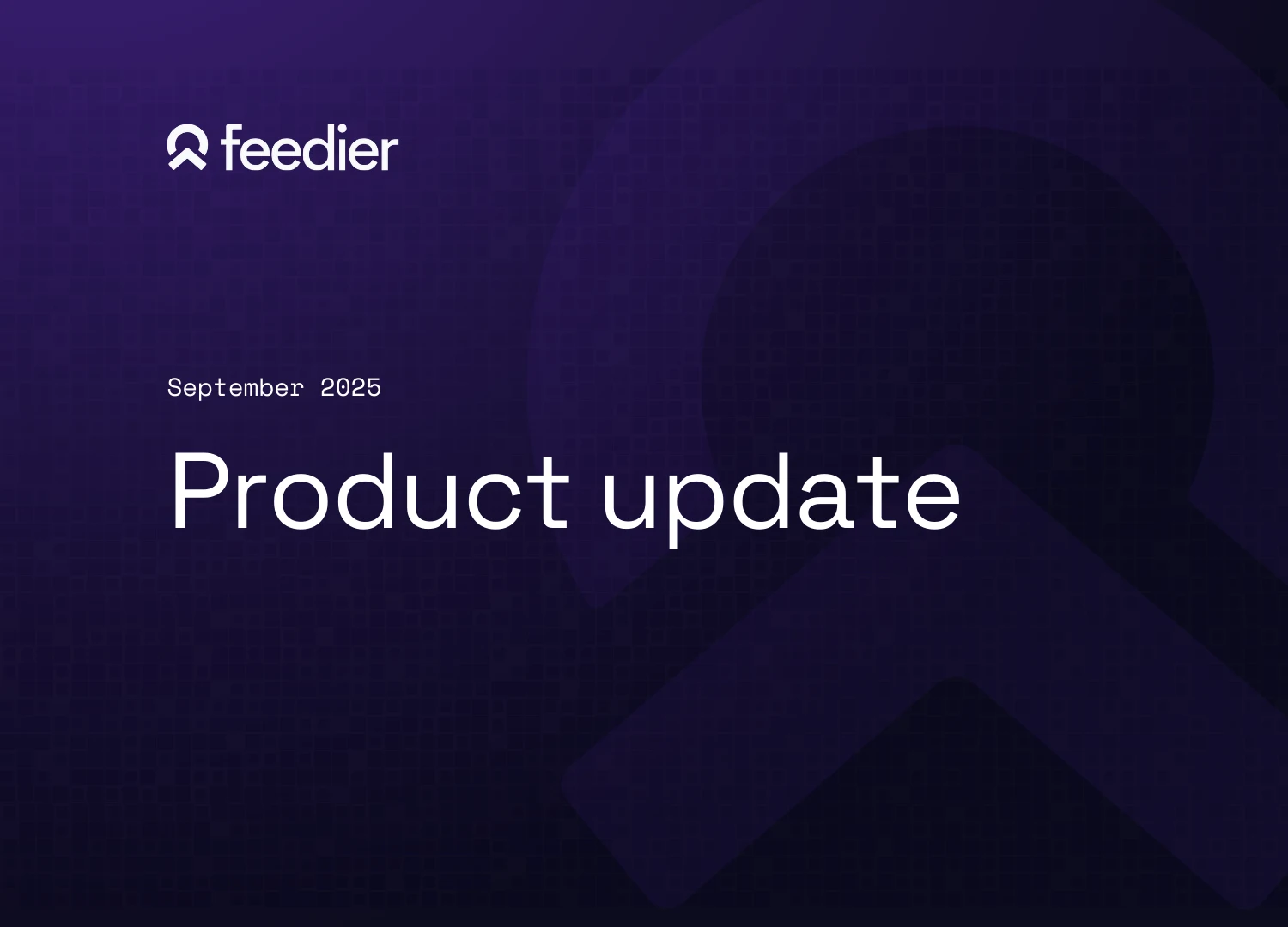
Semantic Analysis in CX: How AI is Redefining the Customer Experience

Semantic analysis is the technology that allows a machine to read and understand human language in your customer feedback. In practice, it sorts your thousands of feedback entries by topic (delivery, product, customer service), measures positive or negative sentiment, and shows you the most frequently used words.
For years, this was enough to get a general overview. Today, however, that approach has become a mere rear-view mirror. The problem is that your customers are accelerating. Over 95% of executives believe their customers are evolving faster than their own companies. Simply looking at the past when customers are changing so quickly is like driving blind. We handle yesterday's problems, miss tomorrow's opportunities, and lose touch with the reality of the lived customer experience.
This is where Artificial Intelligence no longer just improves semantic analysis: it redefines it. Its purpose is no longer just to describe what was said, but to predict what will happen and prescribe the best course of action. AI goes beyond keywords to understand context, detect weak signals that foreshadow future trends, and transform thousands of verbatim comments into a clear, actionable vision.
This article is a guide to understanding this crucial transformation. Together, we will explore, in a simple and concrete way, how AI redefines the customer experience at every level. You will discover how to move from reaction to anticipation to solve problems before they even impact your customers; how to decode the real context and intent behind each piece of feedback, far beyond simple keywords; and how to transform your customer experience into a measurable growth lever, whose financial impact can finally be proven.
Understanding Semantic Analysis
Before exploring how Artificial Intelligence is redefining the customer experience, it's crucial to understand the tool at the heart of this revolution. Far from being just a buzzword, semantic analysis is the mechanism that translates the voice of your customers into a language your business can understand and use.
What is semantic analysis?
Simply put, semantic analysis is the technology that teaches a machine to read and interpret the meaning of human language. Its mission is to take the mass of your written customer feedback, which arrives from everywhere and in many different forms (surveys, online reviews, emails, support tickets, social media), and transform it into structured, understandable information.
What is traditional semantic analysis used for?
In practice, traditional semantic analysis seeks to answer two main questions to make sense of this volume of data:
First, what exactly are your customers talking about? The analysis automatically identifies and classifies the topics being discussed. The system will read a comment and tag it with relevant subjects like "delivery," "product price," "customer service quality," or "website navigation." This helps you know which aspects of your business generate the most discussion.
Second, are they satisfied or not? Once the topics are identified, the analysis measures the general sentiment associated with them (positive, negative, or neutral). It can thus reveal that the "in-store welcome" topic is overwhelmingly positive and a real asset, while "after-sales service" is a recurring source of friction that requires special attention.
Why Traditional Analysis Is No Longer Enough
The result of this analysis is the dashboards we all know well: word clouds and sentiment graphs. This is an essential first building block for quantifying and tracking the voice of the customer.
But this approach has a major limitation: it acts like a rear-view mirror. It accurately describes what has already happened, but struggles to explain the deeper "why" behind behaviors, detect emerging issues, or predict what will happen next. It is effective at analyzing yesterday's problems, but much less so at anticipating tomorrow's challenges. And in a world where "over 95% of executives believe their customers are evolving faster than their own companies," simply looking backward is no longer a viable option.
It is precisely these limitations, the lack of context, the blind spot on emerging issues, and the disconnect from preventive action, where Artificial Intelligence is now changing the game.
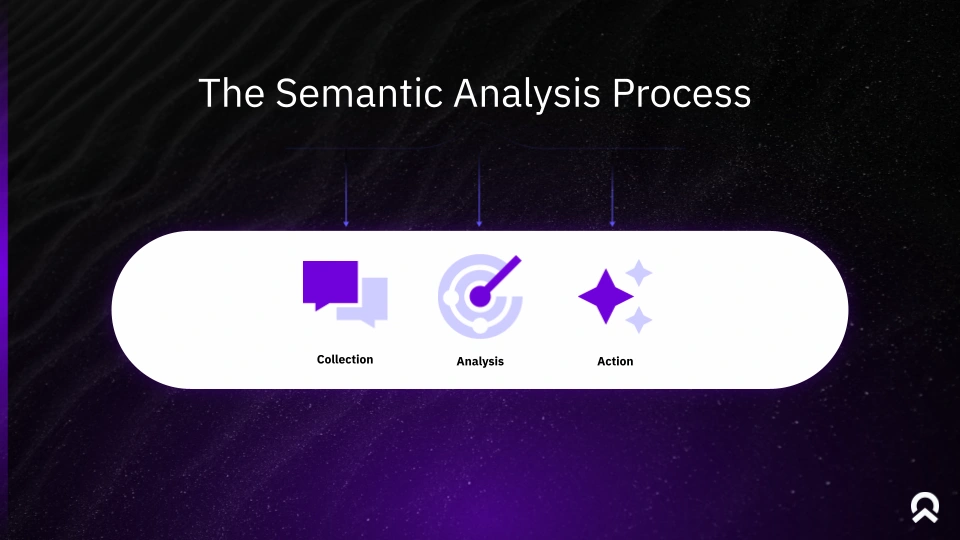
Semantic Analysis and AI: Understanding Context, Intent, and the Invisible
As we've seen, traditional analysis is effective at describing what is visible and already widely expressed. But its value stops where the complexity of human language begins. Artificial Intelligence doesn't just do the same thing faster; it fundamentally changes the nature of the analysis by introducing three new dimensions of understanding.
Beyond Keywords: Understanding Context
The first AI revolution is its ability to understand context. A traditional system that sees the word "incredible" in the sentence "The delivery time was incredible" might classify the comment as positive. AI, on the other hand, analyzes the entire sentence and understands the irony. It knows that a "bravo" for a late delivery is not a compliment.
This understanding of context, including nuance and double meanings, provides a much more accurate measure of true sentiment. We no longer just count positive or negative words; we interpret the real meaning of the message, which eliminates misinterpretations and makes the analysis more reliable.
Decoding Intent: Knowing What the Customer Really Wants
The second major breakthrough is AI's ability to identify the customer's intent behind their message. Not all feedback is of the same nature or urgency. AI can automatically differentiate between:
- A simple question: "Where can I find my invoice?"
- A suggestion for improvement: "It would be great if the app had a search function."
- An imminent churn risk: "If this isn't fixed by tomorrow, I'm canceling my subscription."
- A customer giving balanced feedback: "The delivery was late, but the driver was very professional and apologized."
By identifying these intentions, the company can automate sorting and prioritization. A churn risk can trigger an immediate alert to a retention team, while a suggestion for improvement is sent directly to the product teams. We no longer treat all feedback the same way; we respond to each intent with the right action.
Detecting the Invisible: The Hunt for Weak Signals
This is perhaps the most strategic capability that AI brings. Beyond context and intent, AI is able to detect weak signals: emerging problems or opportunities that are still invisible to classic analysis.
A weak signal is an emerging topic, mentioned by a small number of customers, but which reveals an underlying trend. This could be a few comments about a slight difficulty using a new feature, or mentions of a competitor's product that is starting to generate buzz.
AI excels at this detection because it can find patterns in immense volumes of data where a human would get lost. It connects isolated comments across different channels to reveal a coherent trend. It is this ability that allows for the shift from a reactive mode (fixing known problems) to a proactive mode (anticipating tomorrow's problems). By understanding context, decoding intent, and detecting the invisible, AI-enriched semantic analysis doesn't just give us a report on the voice of the customer. It provides us with a true GPS to navigate the customer experience and make the right decisions at the right time.
Creating a Tailor-Made Customer Experience with AI & Semantic Analysis
Understanding context, intent, and weak signals isn't just an analytical exercise. The ultimate goal of this deep understanding is to transform a standardized customer experience, designed for the masses, into a series of unique and personalized interactions for each individual.
From Segments to Individual Customer Profiles
The traditional approach to personalization relies on broad segments: "new customers," "loyal customers," "high-spending customers"... This method is useful, but it remains an approximation.
AI-powered semantic analysis allows businesses to move beyond these segments to create an individual CX profile for each customer. By aggregating and analyzing all of a person's feedback over time (their survey responses, reviews, support interactions), AI builds a unique portrait of their relationship with your brand:
- Specific irritants: "This customer is particularly sensitive to delivery times."
- Key satisfaction points: "This customer consistently appreciates the packaging quality and product design."
- Unmet expectations: "This user has suggested a new feature for the app three times."
Your company no longer sees just a customer number, but a person with a history of feelings, expectations, and experiences.
Personalizing Interactions in Real Time
This individual profile becomes a powerful tool for personalizing every point of contact.
Imagine a customer service agent who, even before replying to an email, sees an AI-generated summary: "Warning: This customer has had two billing issues on their last four orders and is very sensitive to the clarity of information." The agent can immediately adapt their tone, anticipate questions, and offer a more relevant solution, turning a potentially confrontational interaction into a positive experience.
Similarly, an intelligent chatbot can use this information to stop giving generic answers, for example, by acknowledging a past issue without the customer needing to repeat themselves.
Adapting the Journey and Communications
Personalization goes far beyond conversations. It allows for the proactive adaptation of the customer journey. Thanks to the semantic analysis of their past feedback, you can avoid sending a customer a marketing campaign for a product they have complained about. Conversely, you can prioritize informing them about an improvement to a feature they had criticized, showing them that their voice has been heard.
Ultimately, AI makes it possible to treat each customer not as an anonymous member of a segment, but as an individual partner in an ongoing conversation. It is this ability to recognize and act on the uniqueness of each customer that constitutes one of the most profound redefinitions of the modern customer experience.
Proving the Value: Connecting Semantic Analysis to Financial Results
Improving the customer experience is a good thing, but proving it brings in money is even better. Customer service is often seen as a cost center, and it's difficult to show management that making customers happy has a direct impact on revenue. AI changes that. It makes it possible to precisely calculate what your improvements bring to the company. Your CX teams can finally present clear numbers and prove the value of their work. Here are three simple methods to do so.
Method 1: Saving Money by Being Proactive
This is the easiest calculation to understand. Every customer call, email, or chat costs your company money (in work hours, tool costs, etc.). By using AI to find and fix problems before they escalate, you reduce the number of customers who need to contact you.
Let's take the example of a telecom company that, thanks to weak signal analysis, detects a budding frustration regarding the new eSIM card activation process. By clarifying the online documentation and training support agents on this specific point, it prevents this small irritant from turning into thousands of calls.
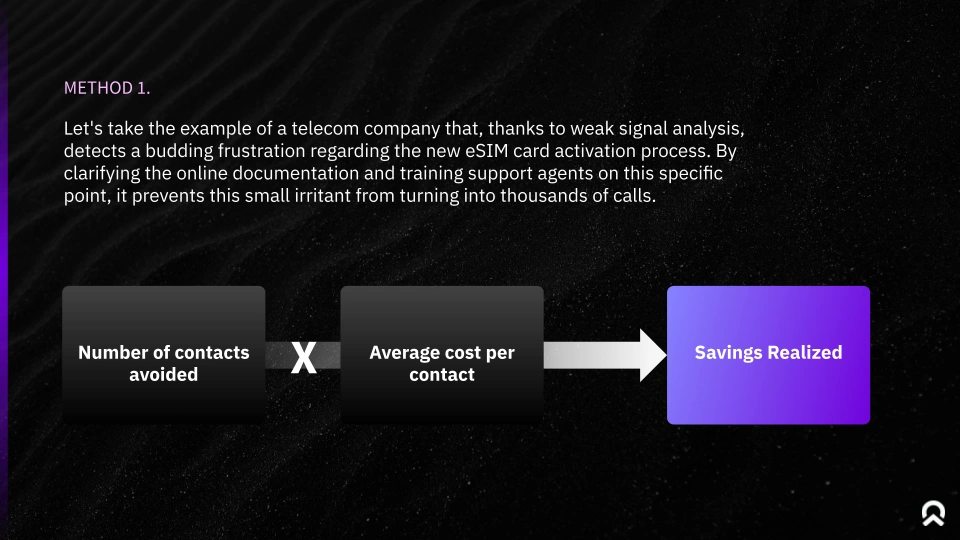
Method 2: Earning More Thanks to Customer Loyalty
A happy and well-understood customer doesn't just avoid contacting support; they buy more often, and for more money. It's a direct growth driver. As we've seen, AI analysis enables personalization that strengthens customer loyalty.
Imagine an e-commerce site that detects, through semantic analysis of abandoned cart comments, that its mobile payment process is considered "complicated" and "too long." By changing the payment funnel from 5 steps to 2 on mobile, the company observes that the average order value for customers using this new version increases by 10%.
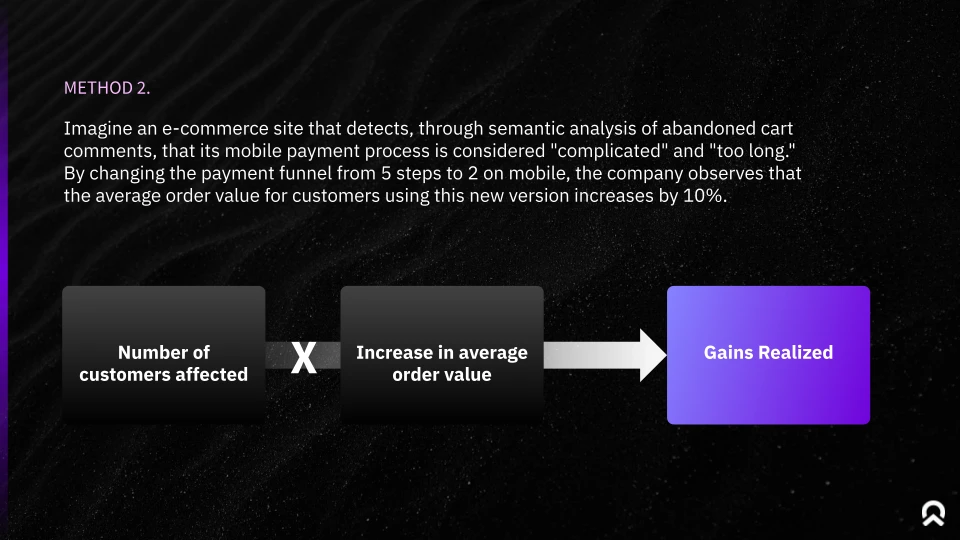
Method 3: Retaining Customers to Protect Revenue
This is the most significant long-term impact. Everyone knows it: retaining a customer costs much less than acquiring a new one. AI-powered semantic analysis is your best defense against "churn," which is the departure of your customers to the competition.
Let's take a retail brand. AI identifies that its online return process, deemed "complicated," is the main reason why customers stop ordering. By simplifying this process, the brand finds that the repurchase rate for customers who have made a return increases by 20%.
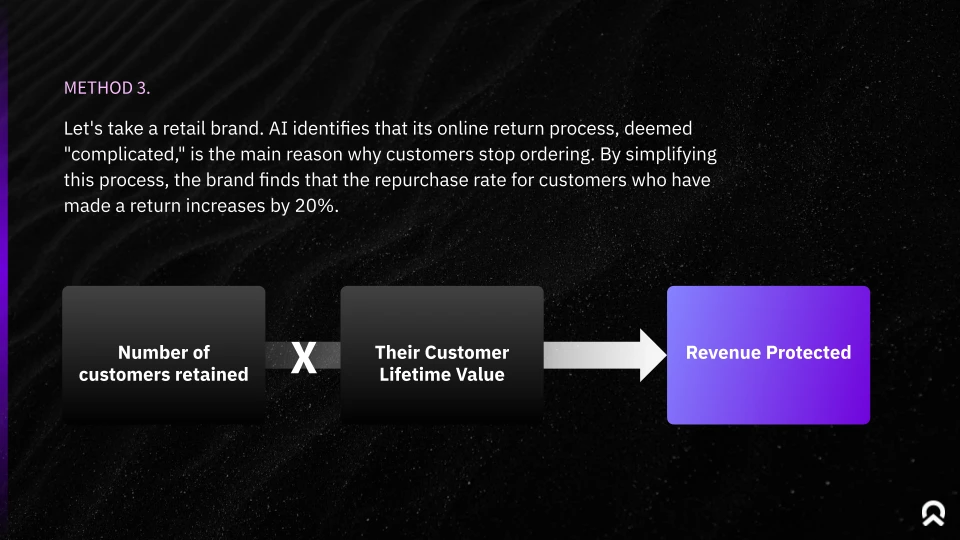
Conclusion
In summary, Artificial Intelligence doesn't just optimize semantic analysis. It transforms it into a performance engine at the heart of the company, with concrete and measurable results.
What we have seen is that this technology allows a shift:
- From analyzing simple keywords to truly understanding the context and intent of each customer.
- From a reactive mode that suffers from problems to a proactive approach that anticipates them by detecting weak signals.
- From mass communication to personalization at scale, where each customer is recognized as a unique individual.
- From a cost center to a profit center, by directly connecting these improvements to a measurable ROI, whether by reducing costs, increasing loyalty, or limiting churn.
The challenge is therefore no longer just about listening, but about having the ability to understand, anticipate, and act with surgical precision. It is this capability, now accessible thanks to AI, that defines the new leaders in customer experience.
About Feedier
Implementing an intelligent, continuous, and action-oriented analysis system may seem complex. This is precisely why Feedier was designed.
Feedier is a customer intelligence platform that helps organizations move from simple feedback collection to true management by the Voice of the Customer. Where traditional tools stop at dashboards, Feedier centralizes all your customer signals (surveys, reviews, tickets, CRM data), automatically detects weak signals, context, and intent thanks to AI, and helps you transform these insights into clear, prioritized, and shareable action plans.
Designed for CX teams who want to go beyond scores and word clouds, our platform gives you the means to act on what really matters to your customers, in real time.
Ready to transform your approach to the customer experience? Get a demo
The Ultimate Guide to the Voice of the Customer 2025

Marketing projects assistant at Feedier. Her assignment is to develop the company's visibility by creating content and organizing events.
Our articles for further exploration
A selection of resources to inform your CX decisions and share the approaches we develop with our clients.


